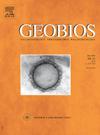A new species of Lovebird (Aves, Psittaculidae, Agapornis) from the Plio-Pleistocene of the Cradle of Humankind (Gauteng, South Africa)
IF 1.6
4区 地球科学
Q2 PALEONTOLOGY
引用次数: 0
Abstract
A new parrot species of the genus Agapornis (Aves, Psittaculidae), namely Agapornis longipes nov. sp., is described from the Plio-Pleistocene of Kromdraai, Cooper’s Cave, and Swartkrans in the Cradle of Humankind, South Africa. The new species is represented by all major wing bones (humerus, ulna, and carpometacarpus) and by the tarsometatarsus, together with a fragmentary mandible and coracoid. The size of the bones indicates a small species of Agapornis with an elongated tarsometatarsus, proportionately the longest of all known species of Agapornis. This lengthening of the legs might be related to feeding adaptation of the extinct species, as the longer legs may have favored this ground feeder in the high and dense grassland characteristic of the Cradle of Humankind during the Plio-Pleistocene transition and the Early Pleistocene.
人类摇篮上新世-更新世恋鸟一新种(鸟鸟科)
在南非人类摇篮的Kromdraai、Cooper’s Cave和Swartkrans的plio -更新世发现了一种新的Agapornis(鸟类,鹦鹉科),即Agapornis longipes nov. sp.。新种的特征包括所有主要的翼骨(肱骨、尺骨和腕骨)和跗跖骨,以及残片的下颌骨和喙骨。骨骼的大小表明这是一种小型的阿加波尼斯,它的跗跖骨很长,是已知的阿加波尼斯物种中最长的。这种腿的延长可能与灭绝物种的进食适应有关,因为在上新世-更新世过渡时期和更新世早期,较长的腿可能有利于这种在人类摇篮特征的茂密草原上的地面捕食者。
本文章由计算机程序翻译,如有差异,请以英文原文为准。
求助全文
约1分钟内获得全文
求助全文
来源期刊

Geobios
地学-古生物学
CiteScore
3.30
自引率
6.20%
发文量
28
审稿时长
6-12 weeks
期刊介绍:
Geobios publishes bimonthly in English original peer-reviewed articles of international interest in any area of paleontology, paleobiology, paleoecology, paleobiogeography, (bio)stratigraphy and biogeochemistry. All taxonomic groups are treated, including microfossils, invertebrates, plants, vertebrates and ichnofossils.
Geobios welcomes descriptive papers based on original material (e.g. large Systematic Paleontology works), as well as more analytically and/or methodologically oriented papers, provided they offer strong and significant biochronological/biostratigraphical, paleobiogeographical, paleobiological and/or phylogenetic new insights and perspectices. A high priority level is given to synchronic and/or diachronic studies based on multi- or inter-disciplinary approaches mixing various fields of Earth and Life Sciences. Works based on extant data are also considered, provided they offer significant insights into geological-time studies.
 求助内容:
求助内容: 应助结果提醒方式:
应助结果提醒方式:


